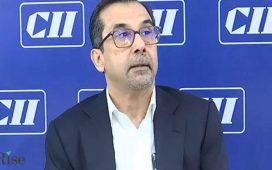For Shigwan, who is the founder and Managing Director of Green India Initiative Private Limited (GIIPL), rural electrification through renewable energy projects has been a decadal journey. But the idea to generate electricity from solar energy germinated in the late 2009s when he was working with the Rotaract Club’s rural development project. Shigwan was tackling several issues-from malnutrition to access to clean water, but he soon realised there was a common thread between all the problems.
“The root cause of problems was electricity, or the lack of it. With power, you can get many things done. Your medical equipment can function, power can bring water and villages that get light can also help children study. A simple thing like a fan can operate, which helps people lead a comfortable life,” says Shigwan, 41.

Shigwan, Founder and Managing Director, Green India Initiative Private Limited (GIIPL).
But 15 years ago, tapping solar was not a prevalent practice. “I decided to take a closer look at solar power and spoke to a few friends about it. I managed to get my hands on a solar lantern and made one project, which I submitted to the Rotary Club for execution,” says Shigwan.
The idea was to provide 500 solar lanterns to students in villages of Dahanu, Maharashtra, to replace their kerosene lamps. The project was successful and Shigwan could see the impact in 2009-2010. “The very little that I did had a cascading effect on the community. This is when the idea of Green India Initiative was born,” he says.
Two friends joined Shigwan to start the organisation as an NGO, but they finally decided to register as a for-profit private limited company in 2014.
The workings
But Shigwan was clear that providing a few solar lanterns would do little to make lives better in rural India. Today, the company provides solar street lighting, water pumping systems, solar water filtration systems, solar off-grid systems for schools and solar home lighting for villages, solar water heaters, solar agarbatti making machines, solar grinding machines, and solar fridges, among other products.“We source a few made in India products and we make a few like solar lanterns and street lighting solutions. We assemble the solar off-grid system on the site itself and we design products like crushing and agarbatti machines and the water filtration system,” says Shigwan, who is also called the Solar Man of India.
Green India Initiative is different in the way it operates. “Our end user is not a buyer and our buyer is not the end user. We serve NGOs that want to execute sustainable and green projects in the community. We also serve corporates who want to do their CSR or ESG projects; we help them execute it. We serve as a bridge between the corporates, NGOs and the beneficiaries,” says Shigwan, who set up his company in Mumbai.
Green India Initiative targets an area by creating a list of the beneficiaries and doing a complete need assessment of those beneficiaries. “Similarly, we know the kind of project or programme corporates and NGOs want to implement in the sphere of sustainability. Because we have created goodwill among different stakeholders, people come to us. We go to the hinterlands of India that can be reached only by a bullock cart or by walking. We have walked carrying solar panels on our head … have walked kilometres with construction material. But this is our opportunity to serve people on both sides, and our engineers are getting employment,” says Shigwan.

Solar installation by GIIPL.
Anilkumar Rajan, a Senior Manager at Siro Clinpharm Pvt Ltd, says it partnered with GIIPL to promote renewable energy adoption in the villages of Maharashtra and Telangana. “The projects executed under the partnership included installation of solar off-grid systems in government schools and installing solar water pumping and filtration systems. The project has not only provided tangible benefits like providing electricity, access to clean water and educational opportunities, but has also contributed to enhancing community resilience and empowerment,” says Rajan.
Green India has served more than 12 states, from Jammu in the north to Assam in the east. The company now plans to foray into states like Uttarakhand, UP, and Mizoram.
Solar-powered buildings are increasingly prevalent in urban India, but GIIPL believes the real need for solar energy is where there is no energy or there is no access to coal-based electricity or the utility grid. So, GIIPL targets areas where electricity can be useful for the people’s growth and development. “Some of the villages are proposed by the NGOs who want to do some project or we have a list of villages pan-India where people still have no access to electricity,” Shigwan says.
Even if they have access to electricity, GIIPL says there is the issue of affordability and paying the bills. GIIPL tries to bridge this gap using NGOs and CSR programmes.
By betting big on energy, Shigwan adds the company clocked revenues of Rs 8 crore last financial year.
He is bullish about creating a renewable energy market in rural India. “People in rural India have a willingness to try solar because they have been deprived. I think rural India is where technologies like solar will work better and provide the country an opportunity to reduce our dependence on coal,” Shigwan adds.







